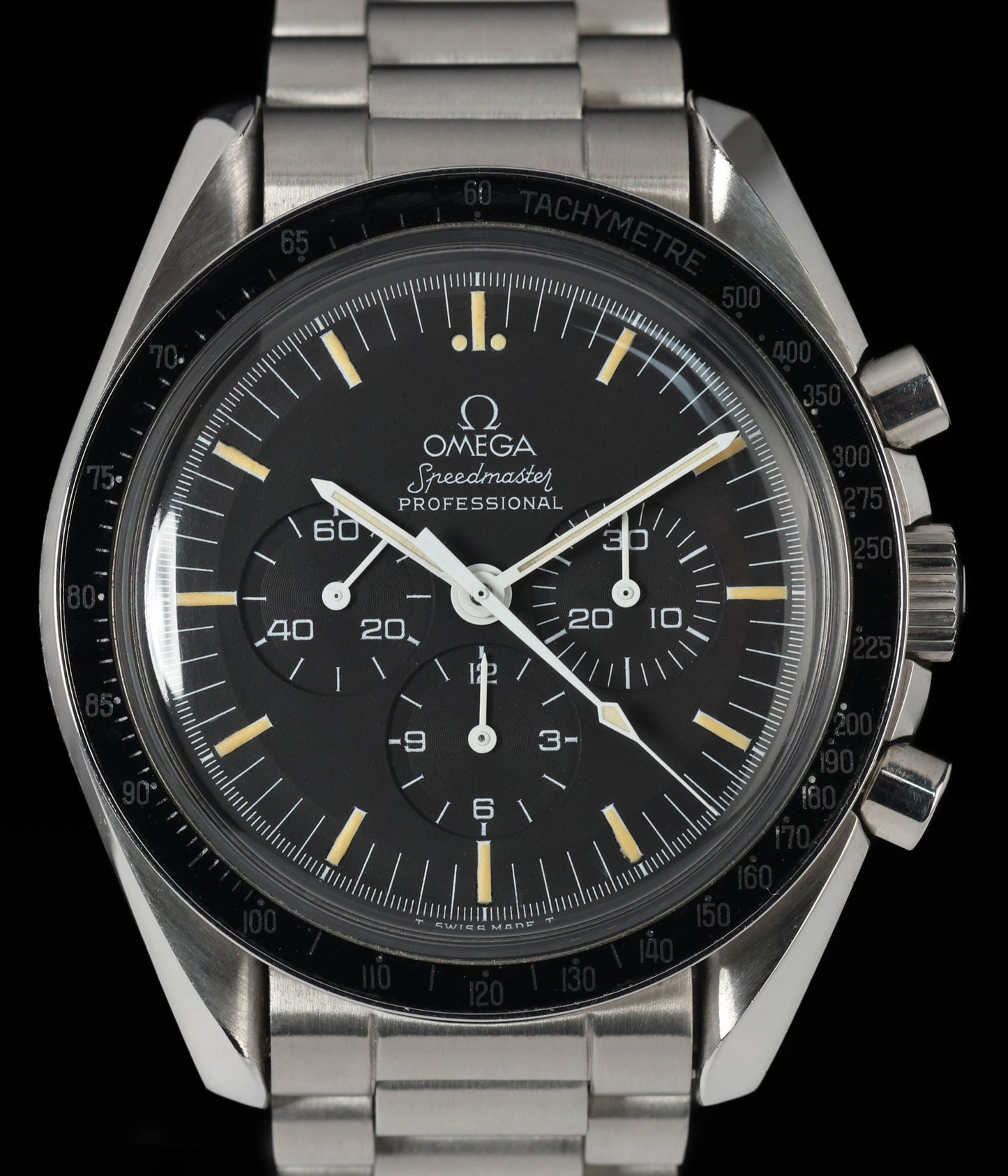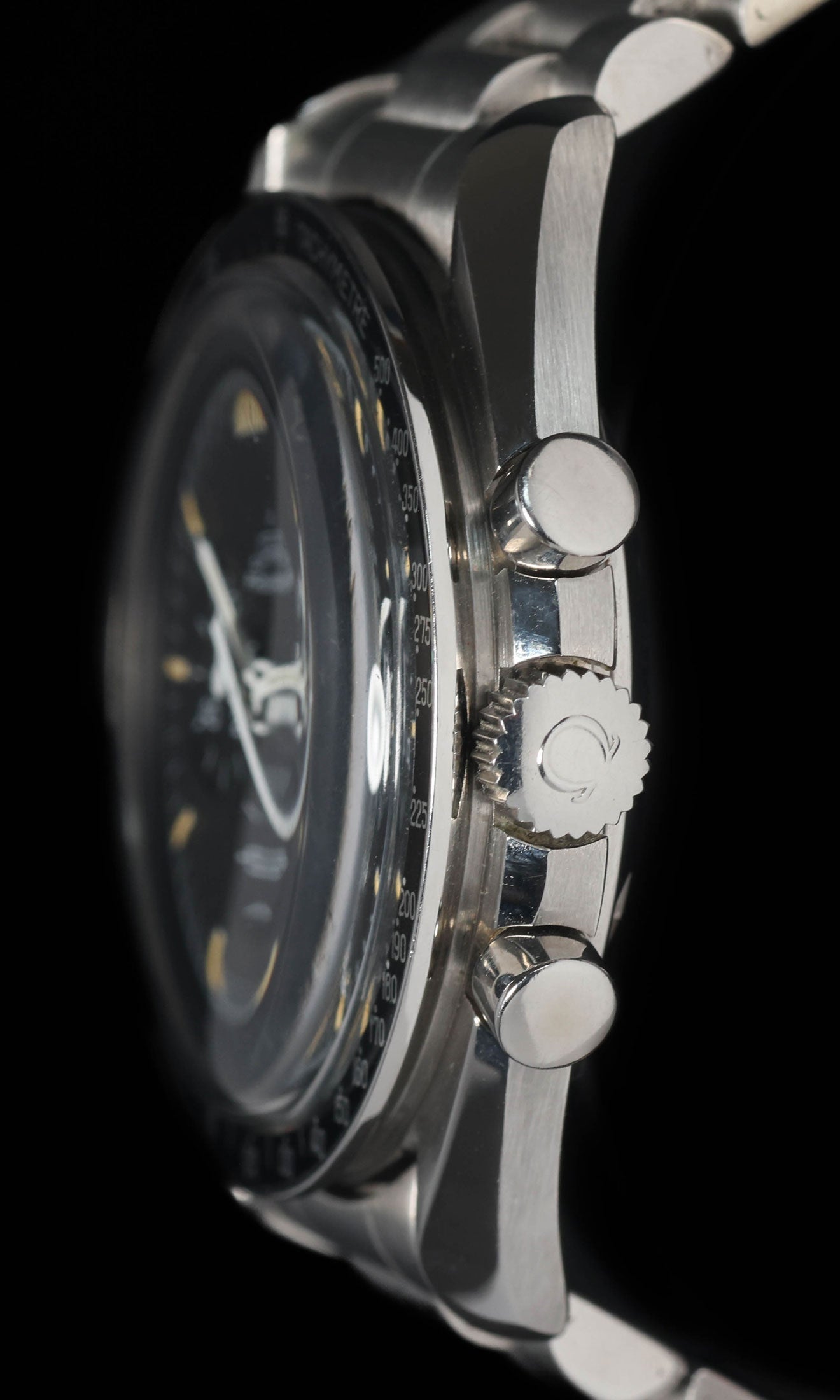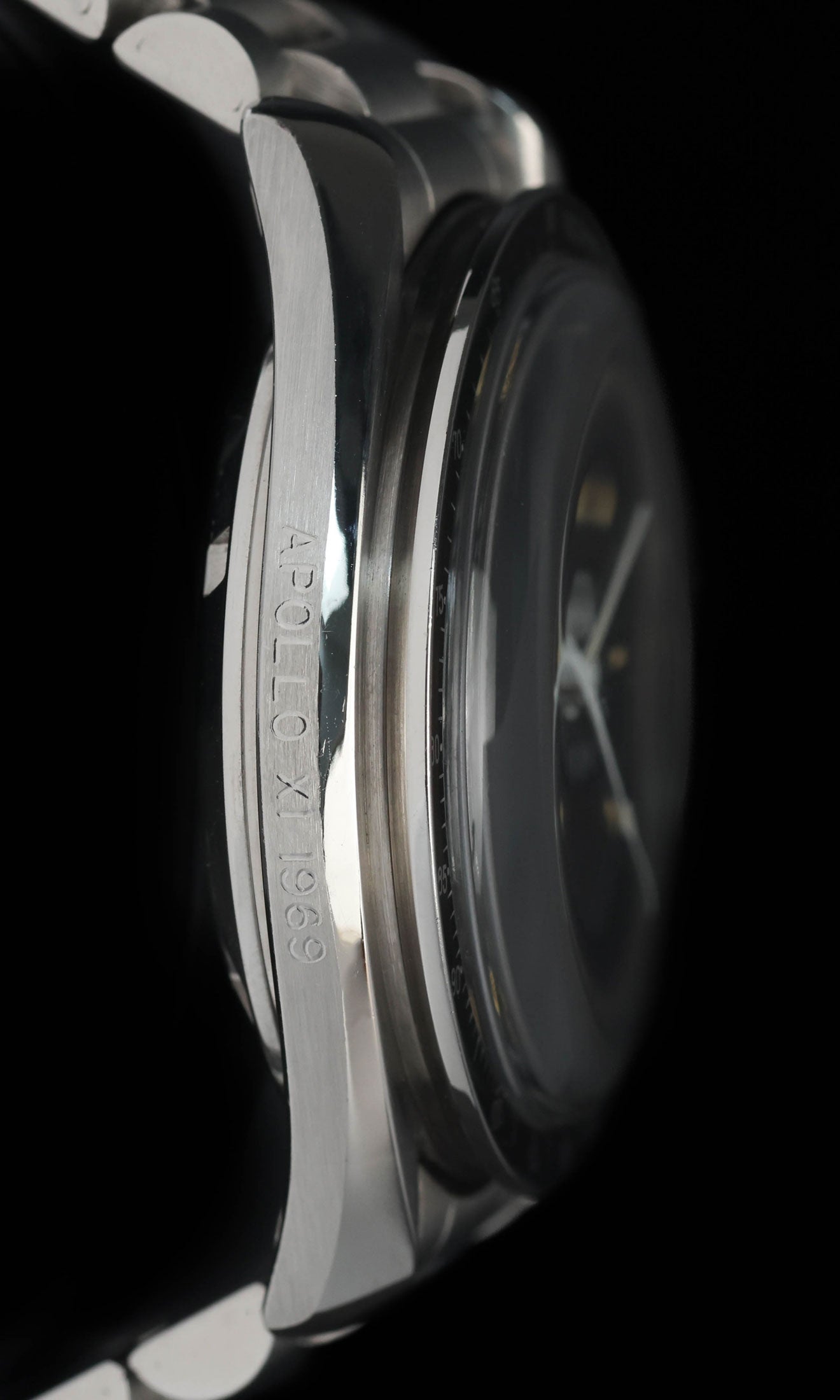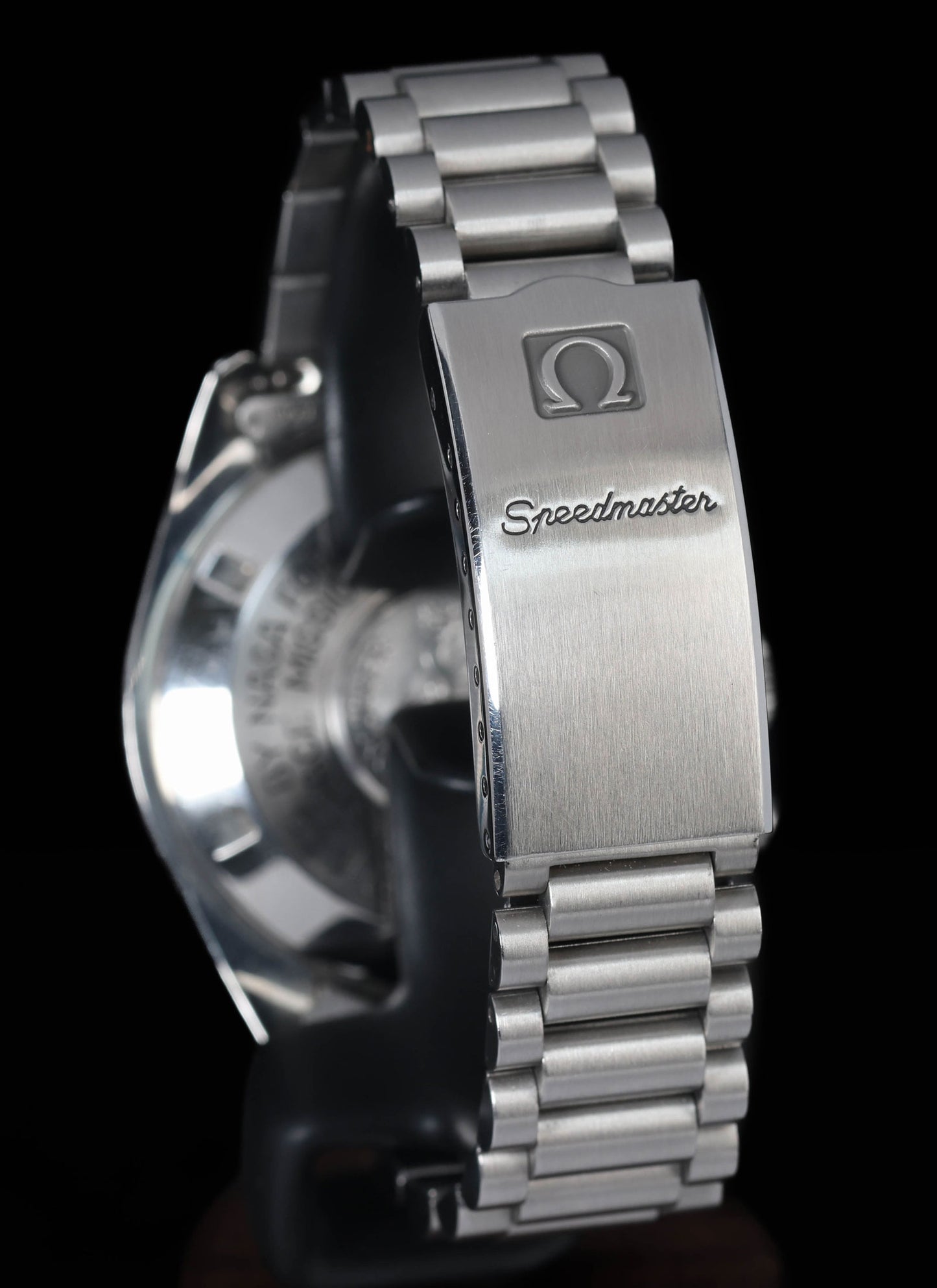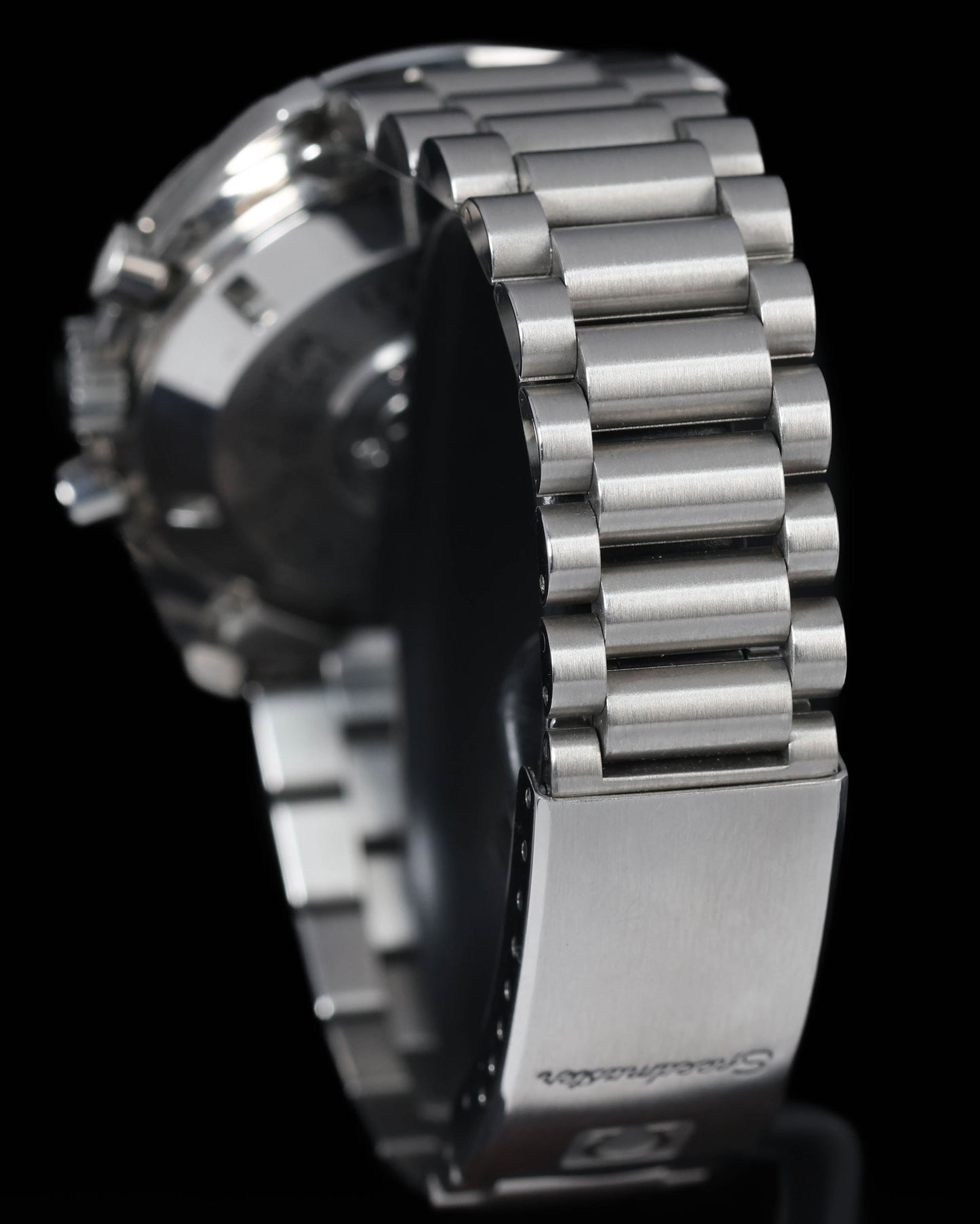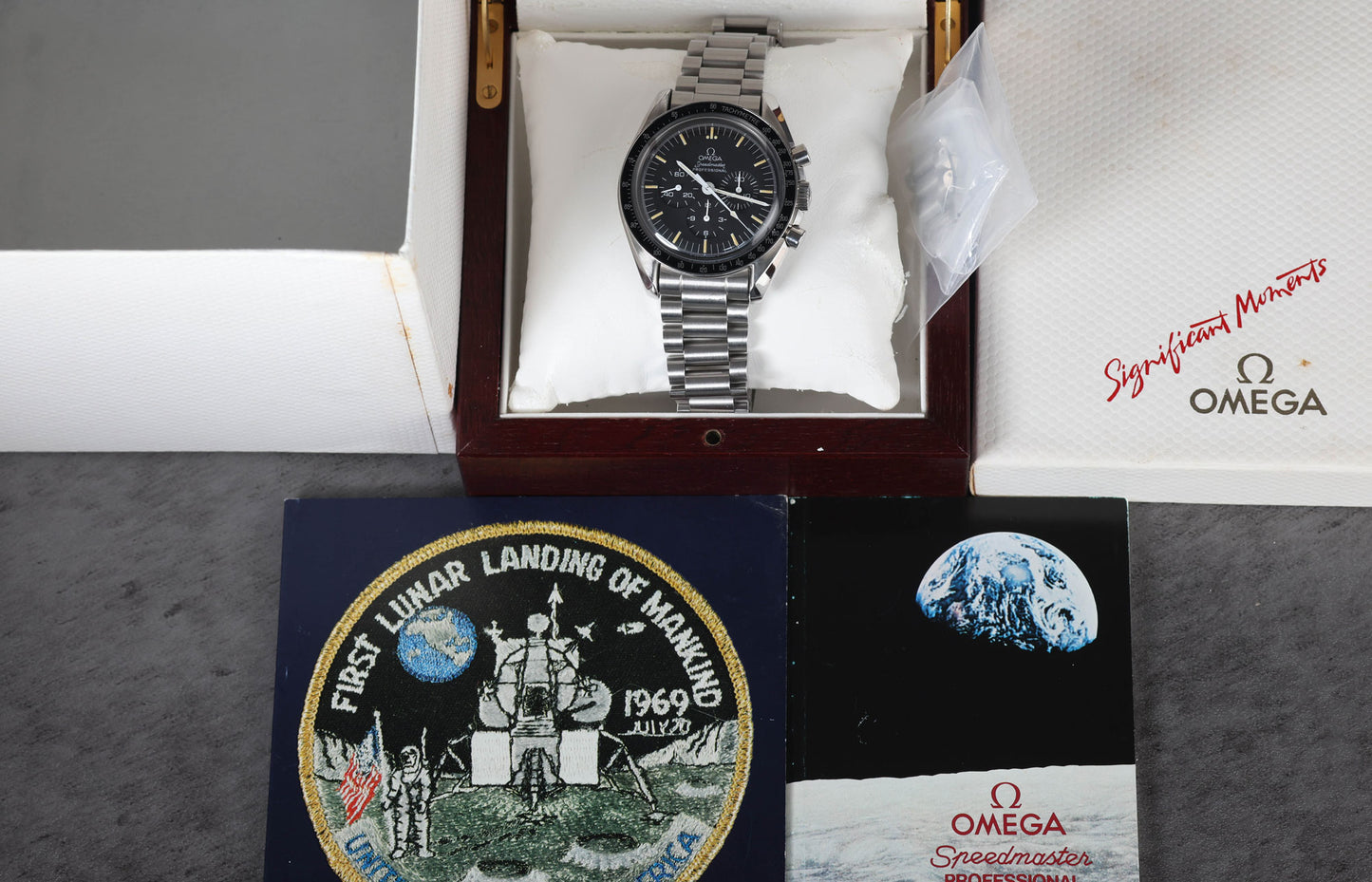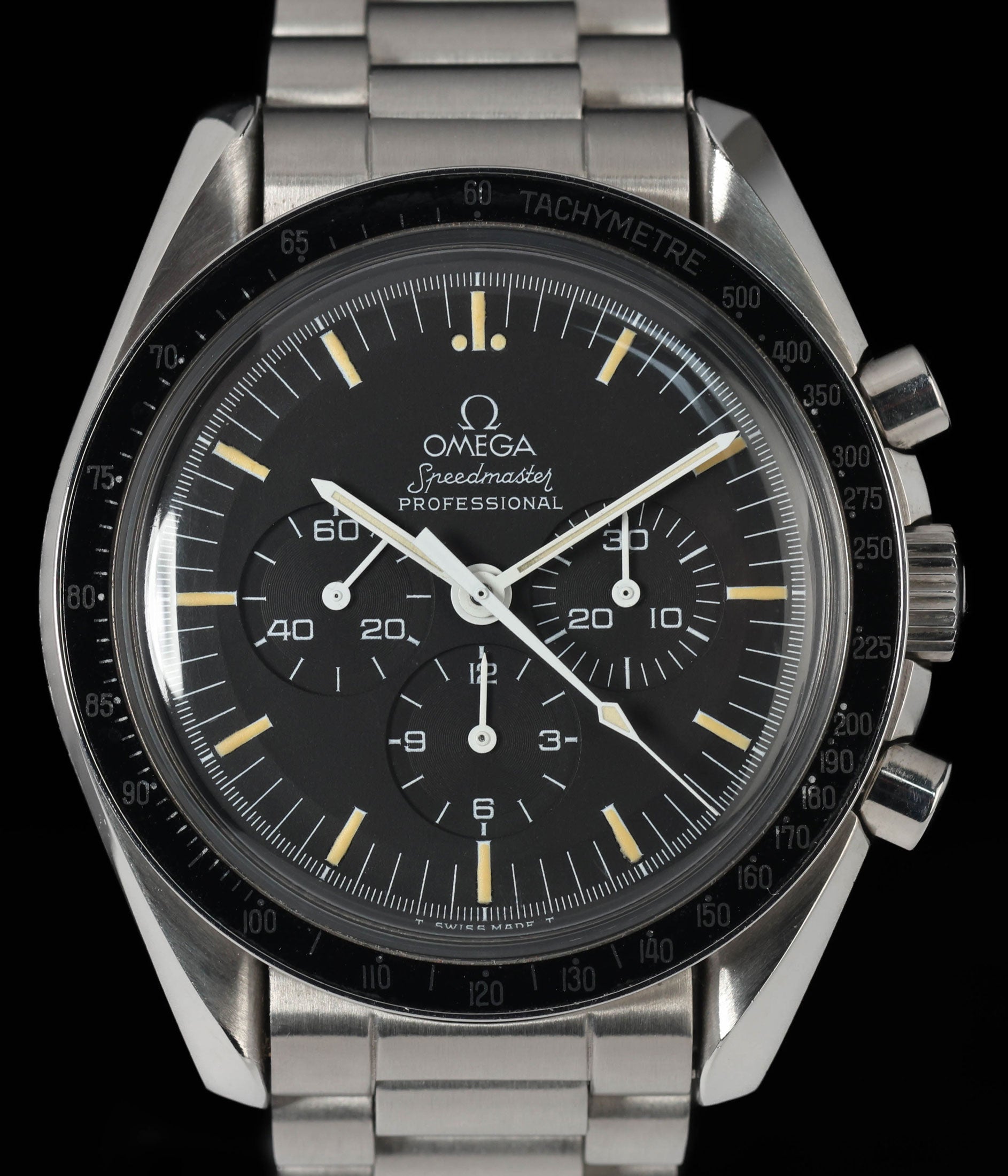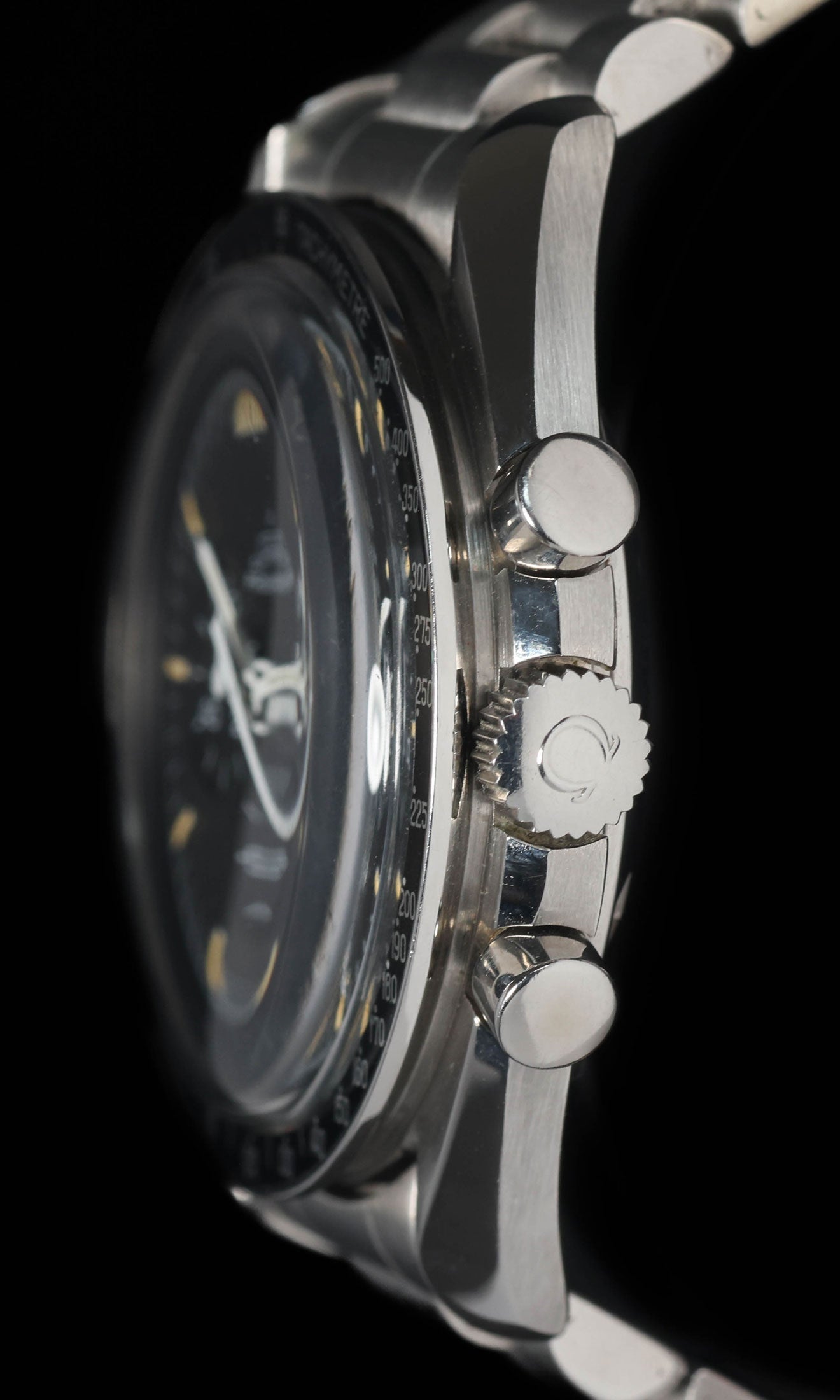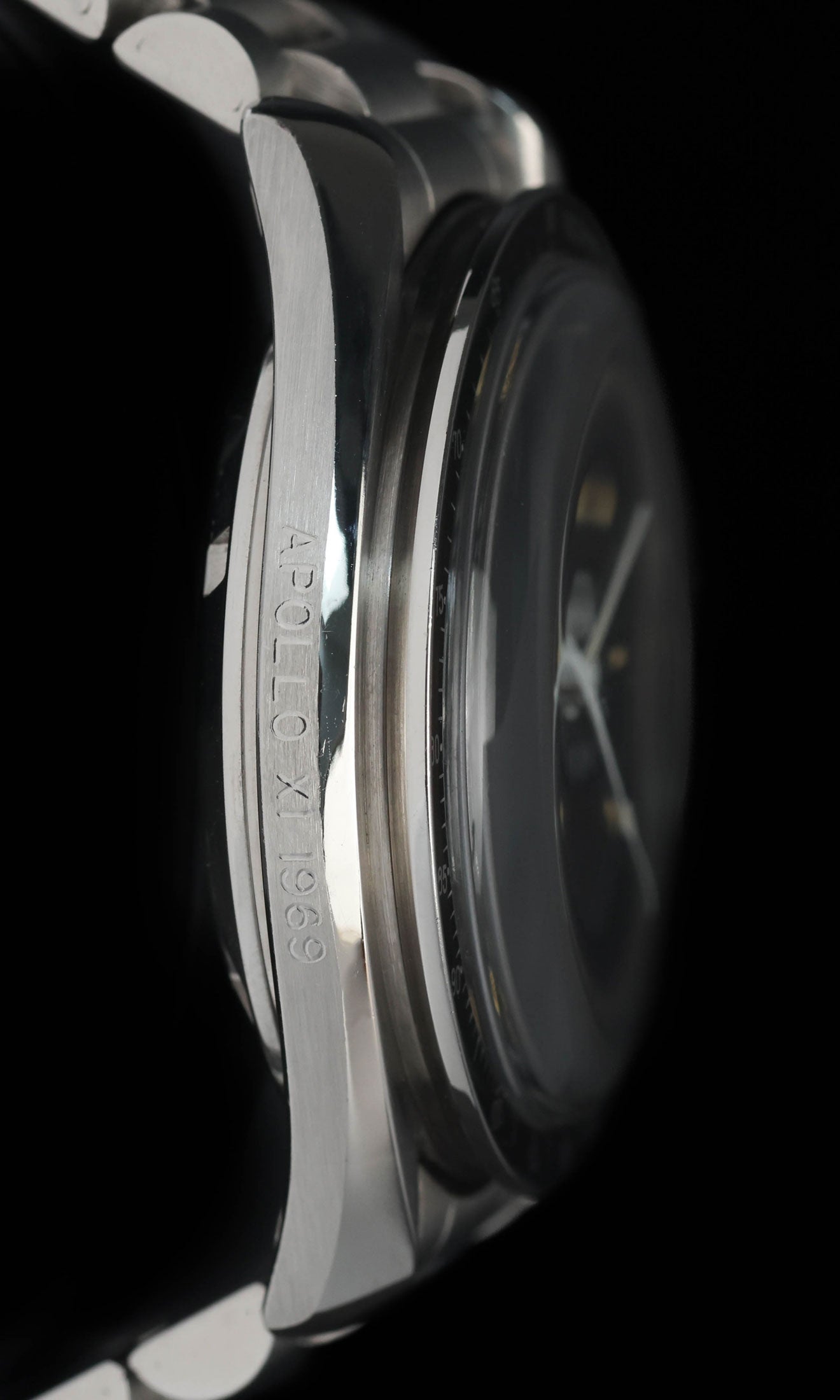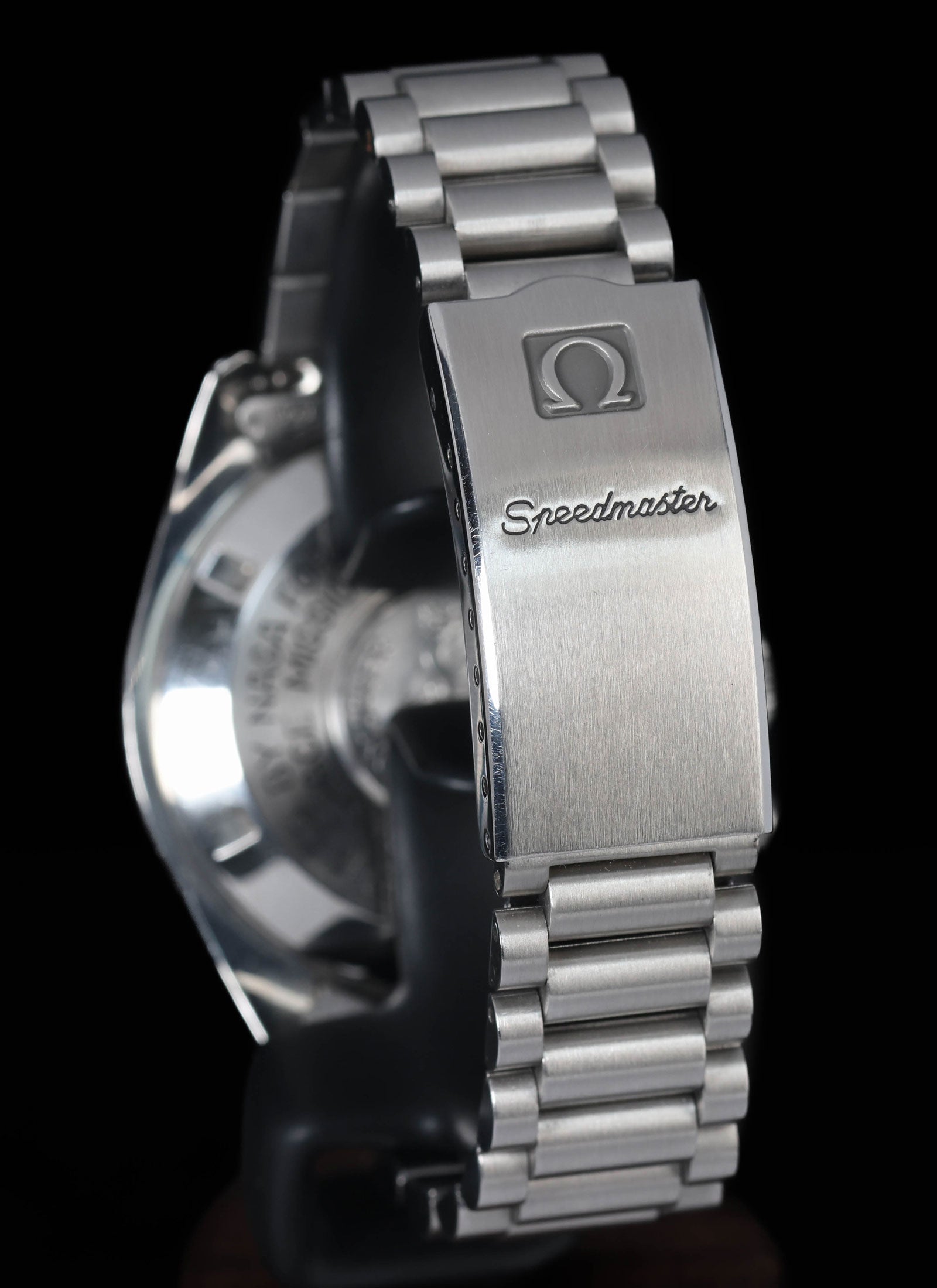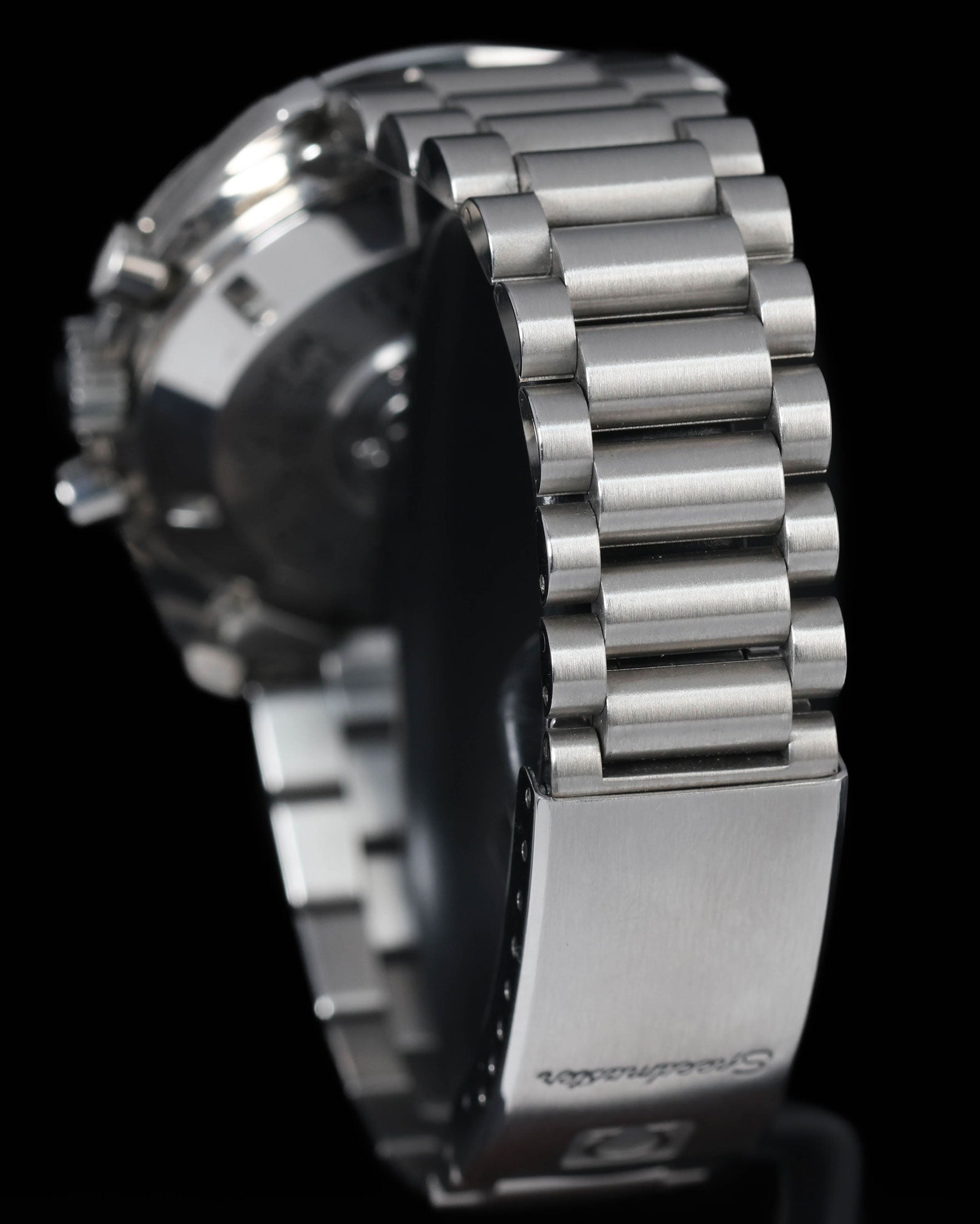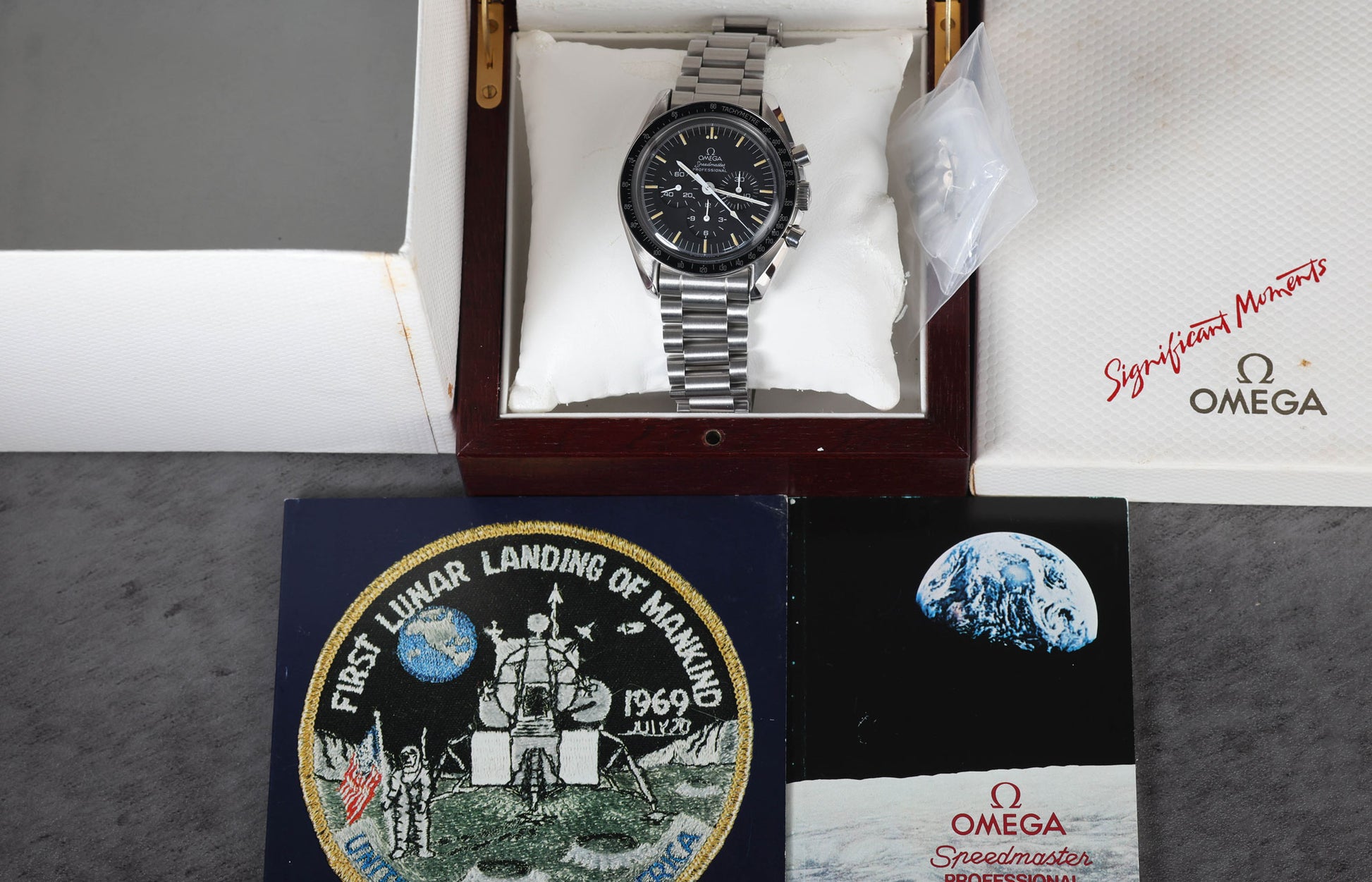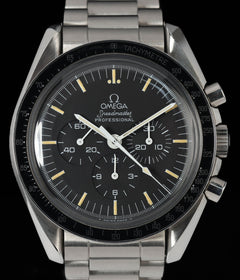Crown Vintage
Omega Speedmaster Professional 345.0802/ ST145.022 Apollo XI 1989 Box & Booklets
Omega Speedmaster Professional 345.0802/ ST145.022 Apollo XI 1989 Box & Booklets
Couldn't load pickup availability
Vintage Omega Speedmaster Professional Apollo XI 345.0802/ ST145.022
Very good overall example, number 0294. The asymmetrical case shows sharp factory edges and crisp “Apollo XI 1969” flank engraving, with no signs of polishing; only light hairlines consistent with careful wear. Original aluminium tachymetre bezel is clean, retaining deep black paint and intact serif numerals. Hesalite crystal is clear and free from cracks or chips. Matte tritium dial and baton hands are flawless, with evenly matched creamy patina on the hour markers. Pushers and crown operate smoothly. Calibre 861 runs strongly and winds without grit; timekeeping within expected tolerances at last check. 1450 bracelet with 808 end-links exhibits minimal stretch and retains original brushed finish; clasp logo sharp. Comes with numbered case-back gasket intact and all reference-correct parts.
Share
Why we love this watch
Why we love this watch
Omega Speedmaster 345.0802 / ST145.022 “Apollo XI”: The Moonwatch Legacy for the Civilian Wrist
Introduction
In the wake of Apollo 11’s Moon landing, Omega wasted no time in bringing space history to the public. While astronauts were strapping on reference 105.012 and 145.012 Speedmasters, Omega was preparing a model that would carry the lunar legacy into boutiques worldwide. That watch was the Speedmaster 345.0802 / ST145.022 “Apollo XI”—a commemorative model based on the 145.022 platform but made to mark the 20th anniversary of the Moon landing.
Released in 1989, this was not just another variant—it was a tribute to a defining moment in human history. It retained the DNA of the classic Moonwatch but added unique caseback engraving, marking it out as a collectible and a symbol of Omega’s role in space exploration.
From Racetracks to Lunar Landings
The Speedmaster’s journey began in 1957 with the reference CK2915. Intended as a professional chronograph for motorsport use, it introduced a clean black dial, triple-register layout, and the now-iconic external tachymeter bezel. Over time, refinements came with the CK2998, 105.003, and 105.012 references.
NASA’s adoption of the Speedmaster was formalised in 1965 after rigorous testing. It became the official chronograph for manned missions, culminating in its historic role during Apollo 11. Buzz Aldrin’s Speedmaster—visible in Moon landing photos—cemented the model’s status as the first watch worn on the Moon.
By 1968, Omega introduced the 145.022 with the new calibre 861 movement, replacing the legendary 321. This move ushered in a new era of Moonwatches—mechanically robust, easier to service, and more accessible to the public.
The Emergence of the 345.0802 / ST145.022
To commemorate the 20th anniversary of the Moon landing, Omega released a special edition Speedmaster in 1989. This was the 345.0802, also referenced as ST145.022 depending on market and documentation. It was based on the standard Moonwatch architecture but added commemorative details that made it distinct.
The standout feature is the engraved caseback, bearing the text:
"APOLLO XI 1969 – 1989”
“Ω Speedmaster – The First Watch Worn on the Moon”
While earlier Speedmasters had engraved tributes, this was the first time Omega explicitly linked a limited edition to Apollo 11 with a numbered caseback (for US models). Approximately 4,000 pieces were produced worldwide, including 1,000 numbered examples for the US market engraved with “XXX / 1000”.
This model allowed collectors, engineers, and the public to wear a direct tribute to Apollo XI on their wrist—without the need to hunt down a 1960s original.
Case, Dial and Crystal
The watch retained the classic 42mm twisted-lug asymmetrical case, first introduced on the 105.012. This design protected the pushers and crown while preserving a comfortable profile on the wrist.
The dial was standard matte black, with tritium lume plots and a printed Omega logo—typical of late-1980s production. It had all the hallmarks of a professional-grade chronograph: recessed sub-dials at 3, 6 and 9, and crisp white markings for instant legibility. The hands were also tritium-filled, with flat counterweights on the chronograph seconds hand—a detail true to Speedmasters produced between 1968 and the mid-1990s.
The crystal was domed Hesalite, chosen for its resistance to shattering—an essential feature for space use. The characteristic etched Omega logo in the centre of the crystal would be present, as Omega had long since begun marking crystals as a quality and authenticity measure.
Movement: Calibre 861
At its heart, the 345.0802 runs the calibre 861—a cam-lever chronograph developed by Lemania, Omega’s movement partner. Introduced in 1968, this movement replaced the more complex column-wheel calibre 321. While collectors still prize the 321 for its craftsmanship, the 861 brought higher reliability and improved serviceability.
The 861 ticks at 21,600 vibrations per hour, has a 48-hour power reserve, and uses a cam and shuttle system instead of a column wheel. This simplified chronograph construction is one of the reasons NASA continued to issue Speedmasters throughout Skylab, Apollo–Soyuz, and Space Shuttle missions well into the 1990s.
Bracelet and Bezel
Most 345.0802 examples were delivered with reference 1450 solid-link bracelets, fitted with Omega 808 end links—a sturdy, comfortable combination that signalled the evolution from earlier flat-link or folded-link bracelets.
The bezel is a black anodised aluminium insert with a tachymeter scale. While collectors pay premiums for early “dot over 90” (DON) bezels, this 1989 model uses the later dot next to 90 configuration, appropriate for the period.
Production and Distribution
Omega produced roughly 4,000 examples of the 345.0802 in total:
- were allocated to the United States, each with a numbered caseback (e.g. “0523 / 1000”).
- Apollo XI engraving.
This relatively small production run adds a layer of scarcity, particularly for collectors seeking complete, untouched examples with original box and papers.
Speedmasters in Service After Apollo
Although the Apollo missions ended in 1972, the Speedmaster’s role in space did not. NASA continued issuing the 145.022 platform (including variants like the 345.0802) throughout Skylab and the Apollo–Soyuz Test Project. It was requalified in 1978 for continued use during the Space Shuttle era, surviving new rounds of environmental and structural testing.
Astronauts like John Young, Story Musgrave, and Sally Ride wore Speedmasters on later missions. Meanwhile, Soviet and European cosmonauts adopted them aboard Soyuz and MIR space stations, cementing the Speedmaster’s reputation as the global standard for manned spaceflight chronographs.
Collectability and What to Look For
When collecting the 345.0802, condition and completeness matter. Desirable traits include:
- with creamy tritium patina (no relume)
- especially if it’s a numbered U.S. market piece
- with 808 end links
- specific to the Apollo XI edition
Compared to earlier Speedmasters with calibre 321 movements, the 345.0802 is more attainable—but no less significant. It’s an honest Moonwatch with real lunar lineage, made to be worn and appreciated.
Final Thoughts
The Omega Speedmaster 345.0802 / ST145.022 “Apollo XI” 20th Anniversary edition is more than a commemorative release—it’s the bridge between Omega’s past glories and its modern legacy. Rooted in the architecture of the classic Moonwatch, powered by the calibre 861, and wrapped in a case that stayed true to its spacefaring origins, it brings a piece of Apollo history to the wrist of anyone lucky enough to own one.
Unlike six-figure 1960s Speedmasters, this model offers a wearable and historically rich alternative—officially sanctioned, appropriately engraved, and built on the same platform that travelled to the Moon. For collectors and space history aficionados alike, the 345.0802 remains one of the most meaningful tributes to the greatest voyage ever made.
Case & Bracelet
Case & Bracelet
Very good condition. No signs of polishing. Bracelet has minimal stretch.
Dial & Hands
Dial & Hands
Dial and hands are flawless. Creamy patina on hour markets.
Warranty & Condition
Warranty & Condition
Crown Vintage Watches provides a minimum 3-month mechanical warranty on pre-owned watches, from the date of purchase.
The warranty covers mechanical defects only.
The warranty does not cover damages such as scratches, finish, crystals, glass, straps (leather, fabric or rubber damage due to wear and tear), damage resulting from wear under conditions exceeding the watch manufacturer’s water resistance limitations, and damage due to physical and or accidental abuse.
Please note, water resistance is neither tested nor guaranteed.
Shipping and insurance costs for warranty returns to us must be covered by the customer. Returns must be shipped via traceable courier. Return shipment must be pre-paid and fully insured. Collect shipping will be refused. In case of loss or damages, the customer is liable.
Our Pledge
At Crown Vintage Watches, we stand by the authenticity of every product we sell. For added peace of mind, customers are welcome to have items independently authenticated at their own expense.
Condition
Due to the nature of vintage timepieces, all watches are sold as is. We will accurately describe the current condition and working order of all watches we sell to the best of our ability.
Shipping & Refund
Shipping & Refund
